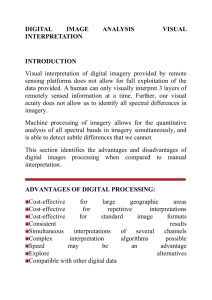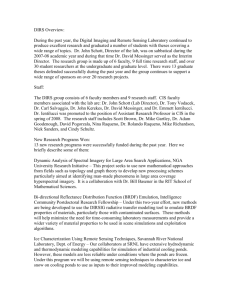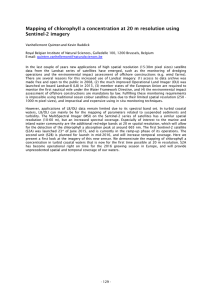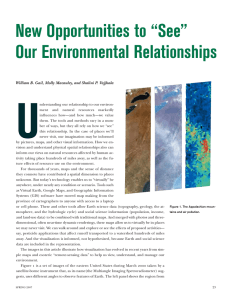IMAGE-BASED VERSATILE LU INFORMATION: A MULTIDIMENSIONAL CLASSIFICATION SCHEME
advertisement
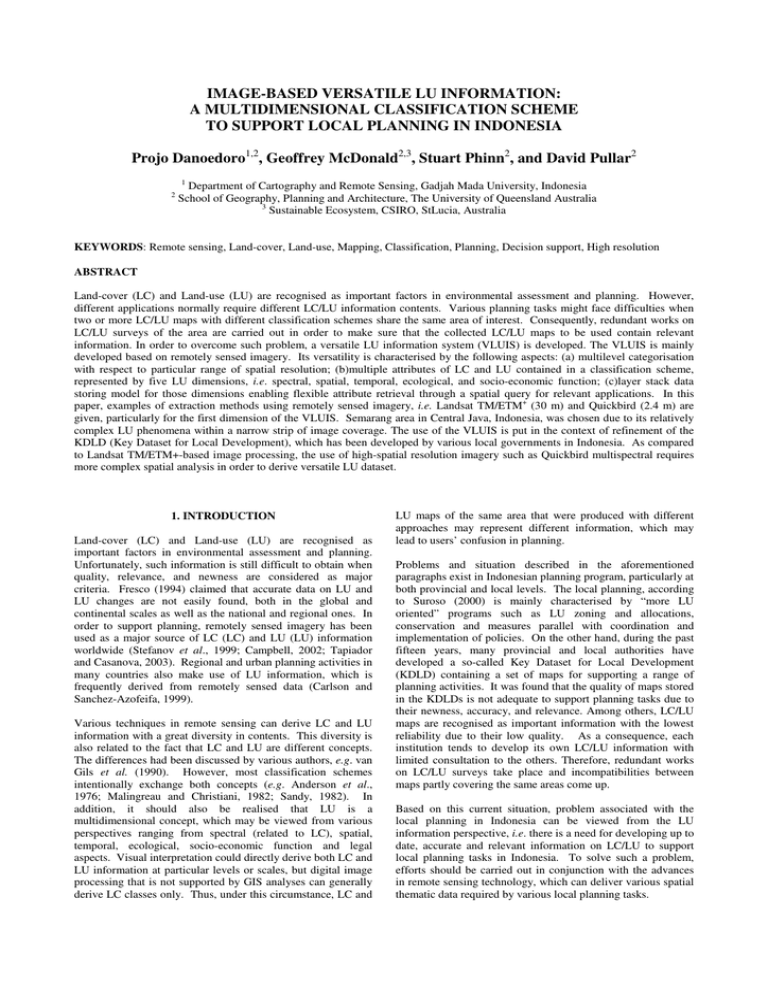
IMAGE-BASED VERSATILE LU INFORMATION:
A MULTIDIMENSIONAL CLASSIFICATION SCHEME
TO SUPPORT LOCAL PLANNING IN INDONESIA
Projo Danoedoro1,2, Geoffrey McDonald2,3, Stuart Phinn2, and David Pullar2
2
1
Department of Cartography and Remote Sensing, Gadjah Mada University, Indonesia
School of Geography, Planning and Architecture, The University of Queensland Australia
3
Sustainable Ecosystem, CSIRO, StLucia, Australia
KEYWORDS: Remote sensing, Land-cover, Land-use, Mapping, Classification, Planning, Decision support, High resolution
ABSTRACT
Land-cover (LC) and Land-use (LU) are recognised as important factors in environmental assessment and planning. However,
different applications normally require different LC/LU information contents. Various planning tasks might face difficulties when
two or more LC/LU maps with different classification schemes share the same area of interest. Consequently, redundant works on
LC/LU surveys of the area are carried out in order to make sure that the collected LC/LU maps to be used contain relevant
information. In order to overcome such problem, a versatile LU information system (VLUIS) is developed. The VLUIS is mainly
developed based on remotely sensed imagery. Its versatility is characterised by the following aspects: (a) multilevel categorisation
with respect to particular range of spatial resolution; (b)multiple attributes of LC and LU contained in a classification scheme,
represented by five LU dimensions, i.e. spectral, spatial, temporal, ecological, and socio-economic function; (c)layer stack data
storing model for those dimensions enabling flexible attribute retrieval through a spatial query for relevant applications. In this
paper, examples of extraction methods using remotely sensed imagery, i.e. Landsat TM/ETM+ (30 m) and Quickbird (2.4 m) are
given, particularly for the first dimension of the VLUIS. Semarang area in Central Java, Indonesia, was chosen due to its relatively
complex LU phenomena within a narrow strip of image coverage. The use of the VLUIS is put in the context of refinement of the
KDLD (Key Dataset for Local Development), which has been developed by various local governments in Indonesia. As compared
to Landsat TM/ETM+-based image processing, the use of high-spatial resolution imagery such as Quickbird multispectral requires
more complex spatial analysis in order to derive versatile LU dataset.
1. INTRODUCTION
Land-cover (LC) and Land-use (LU) are recognised as
important factors in environmental assessment and planning.
Unfortunately, such information is still difficult to obtain when
quality, relevance, and newness are considered as major
criteria. Fresco (1994) claimed that accurate data on LU and
LU changes are not easily found, both in the global and
continental scales as well as the national and regional ones. In
order to support planning, remotely sensed imagery has been
used as a major source of LC (LC) and LU (LU) information
worldwide (Stefanov et al., 1999; Campbell, 2002; Tapiador
and Casanova, 2003). Regional and urban planning activities in
many countries also make use of LU information, which is
frequently derived from remotely sensed data (Carlson and
Sanchez-Azofeifa, 1999).
Various techniques in remote sensing can derive LC and LU
information with a great diversity in contents. This diversity is
also related to the fact that LC and LU are different concepts.
The differences had been discussed by various authors, e.g. van
Gils et al. (1990). However, most classification schemes
intentionally exchange both concepts (e.g. Anderson et al.,
1976; Malingreau and Christiani, 1982; Sandy, 1982). In
addition, it should also be realised that LU is a
multidimensional concept, which may be viewed from various
perspectives ranging from spectral (related to LC), spatial,
temporal, ecological, socio-economic function and legal
aspects. Visual interpretation could directly derive both LC and
LU information at particular levels or scales, but digital image
processing that is not supported by GIS analyses can generally
derive LC classes only. Thus, under this circumstance, LC and
LU maps of the same area that were produced with different
approaches may represent different information, which may
lead to users’ confusion in planning.
Problems and situation described in the aforementioned
paragraphs exist in Indonesian planning program, particularly at
both provincial and local levels. The local planning, according
to Suroso (2000) is mainly characterised by “more LU
oriented” programs such as LU zoning and allocations,
conservation and measures parallel with coordination and
implementation of policies. On the other hand, during the past
fifteen years, many provincial and local authorities have
developed a so-called Key Dataset for Local Development
(KDLD) containing a set of maps for supporting a range of
planning activities. It was found that the quality of maps stored
in the KDLDs is not adequate to support planning tasks due to
their newness, accuracy, and relevance. Among others, LC/LU
maps are recognised as important information with the lowest
reliability due to their low quality. As a consequence, each
institution tends to develop its own LC/LU information with
limited consultation to the others. Therefore, redundant works
on LC/LU surveys take place and incompatibilities between
maps partly covering the same areas come up.
Based on this current situation, problem associated with the
local planning in Indonesia can be viewed from the LU
information perspective, i.e. there is a need for developing up to
date, accurate and relevant information on LC/LU to support
local planning tasks in Indonesia. To solve such a problem,
efforts should be carried out in conjunction with the advances
in remote sensing technology, which can deliver various spatial
thematic data required by various local planning tasks.
2. STUDY OBJECTIVE
The objective of this study was to develop an image-based
multidimensional LU classification scheme as a part of the
development of versatile LU information system (VLUIS) for
local planning in Indonesia. Following the classification
scheme development, example of LC information extraction as
the first dimension of the VLUIS was given. Image datasets of
Landsat ETM+ and Quickbird covering Semarang area, Central
Java, Indonesia were used. This study is a part of a longer term
research aims to develop versatile LU classification scheme and
information extraction methods for each category within the
scheme, followed by a demonstration in applying the obtained
spatial data to support several local planning tasks.
3. PREVIOUS WORKS
Studies on the development of LC/LU classification systems
have been carried out by various authors. One of the most
eminent systems is the USGS LC/LU classification system
(Anderson et al., 1976), which mixes up LC and LU terms in its
categorisation. The USGS LC/LU classification system is
widely used in various projects in the USA. For Indonesian
environment, Malingreau and Christiani (1982) and Sandy
(1982) also developed systems mixing up LC and CU concepts.
Van Gils et al. (1991) proposed a two-level ‘ITC World LC and
LU Classification’, which tried to separate LC from LU
categories and simultaneously established relations between the
two. Recent development of LC/LU classification systems were
undertaken by Food and Agricultural Organisation (Jansen and
Di Gregorio,1998), Young (1998) and Cihlar and Jansen
(2003).
Similarity between all aforementioned classification systems is
the use of single attribute for each category on each level. The
single attribute of LC/LU categories may become problematic
at the subtler level, e.g. level III and IV of the USGS
classification system, since more detailed information in a
single attribute tends to be more specific. Thus, at a subtler
level, translation or conversion from a classification scheme to
another is inhibited. As a consequence, it is more difficult to
use similar categories under different schemes for practical
purposes, e.g. monitoring of LU change. That is why Young
(1998) emphasised the need for development of LU
classification system containing multiple attributes comparable
to soil properties found in the World Reference base for Soil
Resources.
By using digital satellite imagery, multispectral classification
can automatically derive LC-related spectral classes (Jensen,
1996; Mather, 1999). The tentative categories can then be
regrouped and relabelled into more meaningful LC classes. Liu
et al. (2002) suggested the combination of various automatic
image classification methods, i.e. maximum likelihood, expert
system, and artificial neural network for improving land cover
map accuracy. Derivation of subtler information on LC or LU
through per-pixel image classification can also be done with
contextual information (Stuckens et al., 2003), such as
landscape characteristics related to soil properties and slope
steepness (Folly, 1996; Danoedoro, 2001; Ehlers et al., 2003).
4. METHODS
4.1. Development of Classification Scheme
The classification scheme development was started with the
distribution of questionnaires to 36 stakeholders related to
planning in the study area. Findings obtained from the
questionnaire data was analysed together with previous works
dealing with LU based environmental assessment and
modeling. In addition, several classification schemes widely
used such as USGS LC/LU classification systems (Anderson et
al., 1976), LC/LU classification system for Indonesia
(Malingreau and Christiani, 1982), ITC (van Gils et al., 1991)
were taken into account. Moreover, various concepts related to
LC, LU as viewed from spectral, spatial, temporal, ecological,
and socio-economic aspects were also considered. These
include spectral characteristics of various objects (Hoffer, 1978;
Curran, 1985; and Jensen, 1996); spatial pattern and geographic
position/ site (Lillesand and Kiefer, 2000); temporal pattern of
LC and LU (van Gils et al., 1990), tropical ecology (Ewussie,
1990; Osborne, 2000); and socio-economic aspect of LC and
LU (Sutanto, 1986; Jensen, 2000).
Table 2. Description of each LU dimension used in this
study
LU DIMENSION
Spectral
Spatial
Temporal
Ecological
Socio-economic
function
Legal
DESCRIPTION
Strongly related to, or may directly be identified
based on, spectral information of the objects. In
general, the spectral dimension is expressed by
cover types
Related to particular spatial pattern or
arrangement, position or site, which is normally
used as an additional key factor (besides spectral
dimension) to distinguish one feature from others,
e.g. river, lake, regularly spaced stands, interleave
planting, coastal mudflat
Related to temporal or seasonal changes, e.g..
length of indundation and crop rotation.
Information related to spectral and spatial aspects
is also required to determine temporal dimension.
LC and LU forms express interaction between
vegetation, animals and human activities with the
land they exist. Their existence also represent the
environmental characteristics of the area, e.g.
mangrove formation, upland agriculture, slum
areas
Basically, many LC types and LU functions have
economic or socio-economic functions too.
However, the socio-economic dimension needs to
be explicitly presented, if they have.
Basically it is difficult to extract using remotely
sensed imagery.
A multilevel classification was considered more suitable for
local regions in Indonesia, which show a wide range of areal
coverage. Therefore, various satellite imagery with various
spatial resolutions were taken into consideration. Previous
works using various satellite data were reviewed with respect to
the level of details of the categories generated, methods of
processing used or developed, and accuracy levels reached.
The works of Phinn et al. (2000) and Phinn et al. (2002) were
also taken into account. Meanwhile, types of information to be
included in LU categories were also specified with respect to
the previous works in environmental applications.
4.2. Image Analysis and Classification
Image classification was run based on the classification
scheme. In this study, the first (spectral) dimension of the
versatile LU information was derived using image processing
software. As the study is still in progress, the other dimensions
are being explored using integration of visual interpretation,
image processing, and GIS.
4.2.1. Data and softwares
Two image dataset were used in this study, i.e. Landsat
Enhanced Thematic Mapper Plus (ETM+) bands 1-5 and 7,
and Quickbird high spatial resolution imagery with
multispectral bands 1-4 and panchromatic. The ETM+ imagery
(path/row 120/065) was recorded on 21 August 2002, while the
Quickbird imagery was recorded on 31 August 2002. The
whole area covered by the Quickbird is also covered by the
Landsat. In this study, two image processing softwares were
used, i.e. ENVI 4.0 for most processing tasks, and ERDAS
Imagine 8.7 for particular ones.
The ENVI software was
mainly used for making image subset, selecting samples
through regions of interest (ROIs), assessment of samples’
statistics, execution of multispectral classification and
assessment of classification accuracy. The ERDAS Imagine
8.7 was mainly used for multiresolution image merging, image
reprojection and resampling, and recoding of pixel values
related to LC labels.
4.2.2. Analysis
During the first stage, each image dataset was treated
differently. After geometric correction and subset cropping, the
Landsat ETM+ data was prepared for multispectral
classification at 30 m pixel size. Meanwhile, a multi-resolution
merging of Quickbird imagery using Brovey transform (Vrabel,
1996) was carried out in order to create a new colour composite
imagery with higher spatial resolution, i.e. 0.60 m. Meanwhile,
The original Quickbird multispectral image dataset (2.4 m
spatial resolution) was also preserved for multispectral
classification.
Image classification was performed in three stages. Firstly,
ROI-based sampling that was performed interactively.
Selection of ROIs was mainly based on the collected field data,
even though some additional ROIs were chosen based on local
knowledge, topographic map as well as available aerial
photographs. ROI names were given with respect to the
prepared classification scheme with a slight modification, e.g.
shallow water1, shallow water2, high density broadleaves on
shaded areas. Every time a ROI is chosen, the sample statistics
were evaluated and the class separability between existing ROIs
was also calculated. Especially for Quickbird image dataset,
the ROIs selection was also guided by the display of Broveytransformed multiresolution imagery. By doing so,
homogeneity within each ROI could be evaluated directly, both
visually and statistically. Secondly, image classification and
refinement using class merging. Image classification was
performed using maximum likelihood algorithm. Prior to the
classification execution, computation of statistical separability
between classes was done using transformed divergence and
Jeffrey-Matushita indices (Jensen, 1996).
Thirdly, postclassification using selective majority filtering was applied in
order to aggregate pixels of patchy classes into most common
label within a given window, and to simultaneously preserve
particular classes that are considered minority within a given
window (e.g. linear features with 1-2 pixels width). By this
selective majority, a pixel-based generalisation can be applied
without losing important information conveyed by particular
individual pixels.
5. RESULTS AND DISCUSSION
5.1. The Multidimensional Classification Scheme
Figure 1 shows how particular categories under each dimension
are broken down into subtler classes. Based on the developed
categorisation, examples of spectral-related cover types
classification using Landsat ETM+ and Quickbird imagery are
given.
5.2.
Example for
Classification
the
First
Dimension:
Since the large number of classes obtained from the spectral
classification contains similar generic LC categories, a class
merging operation needs to be run. During this stage, 40
spectral-related tentative cover classes from Landsat ETM+
image was merged to 27 LC classes with respect to the
specified categories and spatial resolution under spectral
dimension of the versatile LU classification scheme. By using
the same procedure, 85 tentative classes obtained from
multispectral classification were merged to 48 spectral
dimension LC classes according to the versatile LU
classification scheme. Figure 8 shows the result.
Accuracy assessment of the classified Landsat ETM+ and
Quickbird images showed that the level of accuracy increases
when the post-classification processes applied (Table 2). The
immediate result of multispectral classification, i.e. original
classified image was less accurate as compared to the classified
images followed by class merging.
Class merging
consequently reduces the number of pixels of omission and
commission. This particularly gives positive effect for tentative
classes having relatively similar characteristics, e.g. shallow
water_1 and shallow water_2 , which were then be merged into
shallow water.
Table 2. Accuracy level of the classified images: original, merged, and majority-filtered classes.
!
#$
!
"
, - .!# !
"
%)
% %# &
$ % '%"
% ) &
$ %*+"
* The Kappa coefficients are put within brackets
'
#%
Automatic
(' ) &
$ ('**"
( $' &
$ %'("
(# +%&
$ (#+#"
% $)&
$ % ) "
(# *+&
$ (+ %"
%) ($&
$ %)+("
SPECTRAL-RELATED COVER DIMENSION
1 Water bodies
2 Vegetation cover
41 Asphalt, concrete
and cemented
surfaces
3 Barren land/open soils
42 Compacted clay
surfaces
4 Paved / impervious
43 Metal, glass, fibreglass
and plastic surfaces
surfaces
44 Others
SPATIAL DIMENSION
1 Water bodies
2 Vegetation structure
and composition
3 Barren land and open
soils
4 Built-up/Paved
surfaces
TEMPORAL DIMENSION
1 Length of inundationrelated features
2 Vegetation changerelated features
3 Open soil changerelated features
4 Development stagerelated features
411 Asphalt
412 Concrete
4121 Concrete, non-coloured
413 Fibre cement
4122 Concrete, coloured (as roof tiles)
11 Sea
12 Lake
131. River
13 River and channel
1321 Irrigation channel
132. Rivulet and channel
14 Pond
15 Others
21 Relatively stable/no
change
22 Seasonal change in
vegetation cover
23 Growing vegetation
241 Continuous planting
24 Rotation planting
2422 Fallow period
22 Coastal and estuarine
environment
23 Riparian vegetation
221 Non-vegetated
tidal mudflat
2221 Avicennia zone
222 Mangrove formation
2223 Bruguiera zone
341 Continuous ricefields
2 Forest-based utilisation
32 Tree-crop planting
342 2x rice + cashcrops
3 Agricultural uses
33 Non-woody plantation
343 1x rice + cashcrop
4 Settlement and
infrastructures
34 Inundated ricefields
344 2x rice + vegetables
35 Dryland cultivation
345 1x rice + vegetables
36 Agroforestry system
346 Rice + fish rearing
'
2222 Rhizopora zone
2224 Others
DIMENSION OF SOCIO-ECONOMIC FUNCTION
1 Water-based utilisation
31 Pasture land
" " #
$% # & &
2421 Cropping period
242 Interrupted planting
ECOLOGICAL DIMENSION
1 Aquatic environment
21 Freshwater wetland
2 Wetland and riverside
environment
3 Lowland and alluvial
land environment
4 Montane and steeper
lands environment
5 Built environment
1322 Drainage channel
1323 Irrigation and
drainage
" " (
$) & *# & &
'
" " )
$+ , ) &
Figure 1. Examples of categorisation developed for each land-use dimension.
3431 1x rice + single
cashcrop
3432 1x rice + multiple
cashcrops
" "
$. +
'
Statistically, however, global majority filtering gives a slightly
better accuracy level than the selective one. The selection of
field reference data and its digitisation in terms of ROIs have
created solid areas with homogeneous labels, matching the
result of global majority filtering that can successfully remove
minor variation within a given window. On the other hand, the
use of selective majority filter preserving particular classes with
1-2 pixels width has generated slightly heterogeneous features
surrounding them. As a result, the omission and commission
slightly increased and the overall accuracy a little bit decreased
as compared to the global majority filtered LC map.
Research in the image classification and information extraction
methods will be carried out in the next phase of the study.
During this phase, methods and their mapping accuracies will
be assessed in order to find the most appropriate and efficient
image processing techniques for generating versatile LU
information. In order to demonstrate the VLUIS versatility,
several local planning tasks that require LU information will be
chosen for modelling. The tasks include industrial site
selection, monitoring LU change, and soil loss prediction
models.
Despite the higher overall accuracy levels and Kappa
coefficients for global majority filtering result of both Landsat7 ETM+ and Quickbird images, the selective majority filtering
gives more reasonable result, particularly in preserving road
and small river network, as well as clusters of settlement with
clay roof tiles. The global majority filter tends to generalise
these features so that they might be omitted from the scene.
6. CONCLUDING REMARKS
The classification result also shows that Quickbird image with
2.4 m spatial resolution tend to give lower classification
accuracy as compared to those with coarser spatial resolution
such as Landsat-7 ETM+. It is parallel to the statement of
Aplin et al. (1999) who said that an increase in spatial
resolution is associated with an increase in internal variability
within land parcels (‘noise’ in the image), which may finally
decrease the classification accuracy on a per-pixel basis.
Moreover, the Quickbird image with 11-bit level of radiometric
resolution (0-2048 grey level for each band) can show different
spectral pattern for the same objects found in Landsat-7 ETM+
image, which is processed in 8-bit radiometric resolution.
Several works on high-spatial resolution imagery have proven
that per-field classification (e.g. Aplin et al., 1999) and textural
or neighbourhood analyses within a given window (e.g. Jenkins
and Phinn, 2002) might generate more accurate classification
results than the ‘traditional’ per-pixel classification. Therefore,
it is necessary to explore such methods for improving the
classification result in the next phase of this study. However,
this study also demonstrated that relatively subtler
categorisation of cover types under the versatile LU
classification scheme can be achieved through a careful
sampling, classification and post-classification processes.
5.4. The Future Works
Once the versatile classification scheme is established, it
requires further studies concentrating on the development of
image analyses and classification methods for generating
categories under other dimensions. Although it is obvious that
all categories specified within the classification scheme can be
mapped using visual interpretation with adequate support of
field data, automated mapping methods are still needed for
more detailed and consistent information extraction. The
availability of high-spatial resolution imagery such as Ikonos,
Quickbird and Orbview should be in balance with the
development of image analysis and information extraction
methods.
To address this challenge, there are two sub-topics of research
for the future works should be conducted:
a. Development of image classification and information
extraction methods with respect to each category
specified in the versatile LU classification scheme;
b. Demonstration of versatility of the developed VLUIS
in various local planning tasks.
During the past years, data availability and quality have become
one of main interests in the development of GIS. Following
these needs, various users also require model applicability and
development. The development of VLUIS can be put in this
context, by which the LU data are supplied and stored in such a
way so that various models and applications may use it as a
common reference for solving their own problems. From the
local planning perspective, the availability of VLUIS should be
put within the frame of KDLD re-establishment, in which the
improvement of LU information should also be undertaken
together with other spatial data. Therefore, the applicability of
the KDLD to support local planning tasks can be realised with
the support of both LU and other relevant spatial data.
Landsat systems have been serving to provide data
continuously during the past 30 years, and the data can be used
as a good basis for monitoring system at both regional and local
levels. This study has proven that the Landsat-7 ETM+
imagery is also accurate to be used as a basis for the VLUIS’
first-dimension (LC type) mapping. However, further studies
are required in order to ensure that this kind of imagery is also
accurate for generating other VLUIS’ dimensions.
It was also found that the Quickbird imagery, with its 2.4
meters spatial resolution, is accurate enough for satisfying LU
mapping tasks with respect to the VLUIS’ first dimension
classification scheme. Although 85% accuracy level might be
considered as ‘marginally accurate’ according to the minimum
level of LU classification accuracy (Campbell, 1983), more
complex analyses can still be developed in order to increase its
accuracy, and these will be conducted in the Phase II. It should
also be noted that the processing methods applied to both
Landsat-7 ETM+ and Quickbird imagery were standard
algorithms followed by a simple neighbourhood analysis
techniques, which could be done using most image processing
systems available in the marketplace. Thus, the future works
may also be expected to explore other methods for increasing
the accuracy levels of the classification.
ACKNOWLEDGEMENTS
The authors wish to thank the Amsterdam Trust Fund, who has
made the poster presentation of this paper possible by
supporting additional funding. Image data delivery from
LAPAN Indonesia (Landsat ETM+) and Sinclair Knight Mertz
Australia (Quickbird) are also acknowledged.
REFERENCES
Anderson, J.R., Hardy, E., Roach, J. and Witmer, R., 1976. A
Land Use and Land Cover Classification System for
Use with Remote Sensor Data. Washington, DC: US
Geological Survey Professional Paper 964, 28 pp
Aplin, P., Atkinson, P.M., and Curran, P.J., 1999. Fine Spatial
Resolution Simulated Satellite Sensor Imagery for
Land Cover Mapping in the United Kingdom.
Remote Sensing of Environment, 68, 206-216
Campbell, J. B., 2002. Introduction to Remote Sensing (3 ed.).
New York: Guilford Press.
Carlson, N., & Sanchez-Azofeifa, G. A., 1999. Satellite Remote
Sensing of Land use Changes in and Around San
Jose, Costa Rica. Remote Sensing of Environment, 70,
247-256.
Cihlar, J., & Jansen, L. J. M., 2003. From Land Cover to Land
Use: A Methodology for Efficient Land Use Mapping
over Large Areas. Professional Geographer, 53(2),
275-289.
Danoedoro, P., 2001. Integration of Remote Sensing and
Geographical Information Systems in Land use
Mapping: An Indonesian Example. In I. S. Zonneveld
& D. van der Zee (Eds.), Landscape Ecology Applied
in Land Evaluation, Development and Conservation:
Some Worldwide Examples. ITC Publication No
81/IALE Publication No. MM-1. Enschede:
International Institute for Aerospace Survey and
Earth Sciences (ITC)/IALE.
Ehlers, M., Gahler, M., & Janowsky, R., 2003. Automated
Analysis of Ultrahigh Resolution Remote Sensing
Data for Biotope Type Mapping: New Possibilities
and Challenges. ISPRS Journal of Photogrammetry
and Remote Sensing, 1252, 1-12.
Ewussie, Y., 1990.
Introduction to Tropical Ecology.
Indonesian translation by Usman Tanujaya.
Bandung: Penerbit ITB
Folly, A., Bronsveld, M. C., & Clavaux, M., 1996. A
Knowledge-based Approach for C-factor Mapping in
Spain using Landsat TM and GIS. International
Journal of Remote Sensing, 17(12), 2401-2415.
Fresco, L. O., 1997. Introduction. In L. O. Fresco & L.
Stroosnijder & J. Bouma & H. van Keulen (Eds.),
The Future of the Land -- Mobilising and Integrating
Knowledge for Land use Options. Chichester: John
Wiley and Sons.
Hoffer, R.M., 1978. Biological and Physical Consideration in
Applying Computer-aided Analysis Techniques to
Remote Sensor Data. In: P.H. Swain and S.M. Davis
(eds). Remote Sensing: the Quantitative Approach.
New York: McGraw Hill
Jansen, L. J. M., & Gregorio, A. D., 1998, May. The Problems
of Current Land Cover Classifications: Development
of a New Approach [URL]. Food and Agricultural
Organization. Retrieved 12 April, 2002, from the
World Wide Web: http://www.fao.org/fao-unep/sd
Jenkins, R. B., & Phinn, S. R., 2002. Mapping the Internal
Structure of Urban Areas by Spatial Reclassification
of High Resolution Imagery (Poster). Paper presented
at the The 11th Australasian Remote Sensing and
Photogrammetry Association Conference -- Image to
Information, Brisbane.
Jensen, J. R., 1996. Introductory Digital Image Processing -- A
Remote Sensing Perspective (2 ed.). Englewood
Cliffs, N.J.: Prentice Hall.
Jensen, J. R., 2000. Remote Sensing of the Environment: An
Earth Resource Perspective. Englewood Cliffs, N.J.:
Prentice Hall.
Lillesand, T. M., & Kiefer, R. W., 2000. Remote Sensing and
Image Interpretation (4 ed.). New York: John Wiley
and Sons.
Liu, X., Skidmore, A. K., & van Oosten, H., 2002. Integration
of Classification Methods for Improvement of Land
Cover Map Accuracy. ISPRS Journal of
Photogrammetry and Remote Sensing, 56, 257-268.
Malingreau, J. P., & Christiani, R., 1981. A Land Cover/Land
Use Classification for Indonesia -- First Revision. The
Indonesian Journal of Geography, 11(41), 13-47.
Mather, P. M., 1999. Computer Processing of Remotely Sensed
Data: An Introduction (2 ed.). Brisbane: John Wiley
and Sons.
Phinn, S. R., Menges,
Optimizing
Monitoring,
Environment.
117-132
C., Hill, G.J.E., Stanford, M., 2000.
Remotely Sensed Solutions for
Modeling, and Managing Coastal
Remote Sensing of Environment, 73:
Phinn, S. R., Stanford, M., Held, A., Ticehurst, C., & Simpson,
C., 2002. Optimizing State of Environment
Monitoring at Multiple Spatial Scales using Remotely
Sensed Data. Paper presented at the The 11th
Australasian Remote Sensing and Photogrammetry
Association Conference -- Image to Information,
Brisbane.
Osborne, P.I., 2000. Tropical Ecosystems and Ecological
Concepts. Cambridge: Cambridge University Press
Sandy, I. M., 1982. Land use di Indonesia (Land use in
Indonesia). Jakarta: Directorate General for Regional
Development, Ministry of Home Affairs.
Stevanof, W. L., Ramsey, M. S., & Christensen, P. R., 2001.
Monitoring Urban Land Cover Change: An Expert
System Approach to Land Cover Classification of
Semiarid to Arid Urban Centers. Remote Sensing of
Environment, 77, 173-185.
Stuckens, J., Coppin, P. R., & Bauer, M. E., 2000. Integrating
Contextual Information with per-Pixel Classification
for Improved Land Cover Classification. Remote
Sensing of Environment, 71, 282-296.
Suroso, D., 2000. Spatial Planning and Environmental
Assessment in Indonesia: A Case Study of the
Strategic Environmental Assessment of the Surabaya
Spatial Plan. Unpublished PhD thesis, The University
of Queensland, StLucia.
Sutanto,, 1986, Penginderaan Jauh Jilid I dan II. Yogyakarta:
Gadjah Mada University Press
Tapiador, F. J., & Casanova, J. L., 2003. Land Use Mapping
Methodology using Remote Sensing for the Regional
Planning Directives in Segovia, Spain. Landscape
and Urban Planning, 62, 103-115.
van Gils, H., Huizing, H., Kannegieter, A., & van der Zee, D.,
1991. The Evolution of the ITC System of Rural
Land use and Land cover Classification (LUCC). ITC
Journal(3), 163-167.
van Gils, H., Zonneveld, I. S., van Wijngaarden, W.,
Kannegieter, A., & Huizing, H., 1990. Land Ecology
and Land Use Survey.Unpublished manuscript,
Enschede.
Vrabel, Jim., 1996, Multispectral Imagery Band Sharpening
Study, Photogrammetric Engineering & Remote
Sensing, Vol. 62, No. 9, pp. 1075-1083.
Young, A., 1998. Land Resources: Now and for the Future.
Cambridge: Cambridge University.
